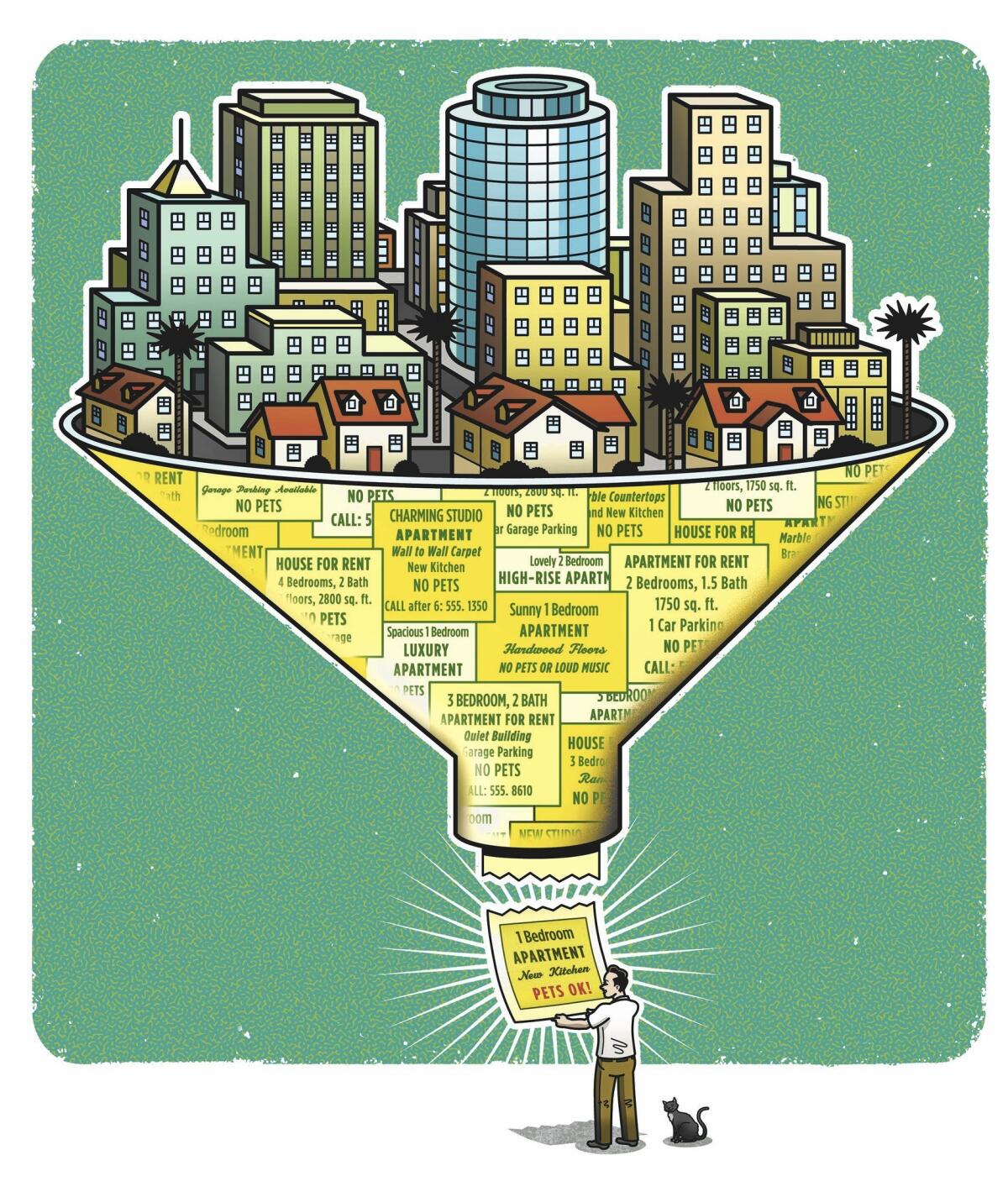Apps, sites aim to transform apartment rental listings

- Share via
For a long time, hunting for an apartment has meant wading through cryptic yard signs, inscrutable classifieds and frustrating games of phone tag.
That’s finally changing.
Mobile-app start-ups, online real estate giants and even old-school local listing firms are gearing up to streamline the splintered business of apartment advertising, looking to make it more reliable for landlords and more user-friendly for tenants. They’re aiming to turn a huge business — 2.3 million households rent in Los Angeles and Orange counties — into a modern marketplace, and make finding a place to live a little easier.
For now, though, many apartment hunters still face challenges that are increasingly rare in the digital age. Consumers can comparison shop for hotel rooms, plane tickets, even houses online or through their smartphones, using data-rich websites to tap up-to-the-second data. But there’s no complete repository for the rental market.
To find a place in L.A. a renter has to scan yard signs, scour Craigslist, stop by leasing offices and search a bevy of websites big and small. No single source shows everything on the market all at once, not even close. Add in the challenge of tracking down landlords by phone, enduring the often-opaque application process and racing fellow renters to be first in line, and finding an apartment can become a disappointing time suck.
It was for Stephanie Wong. She and her cousin spent two months looking for an apartment this past summer, trying to find a place in Palms or Brentwood before their old lease ran out in September. They dug through Craigslist and drove the streets, answered uncomfortable questions from a couple of “kooky” landlords and got beat to the punch on several applications. Finally, they landed a place in Mid-City, a neighborhood they weren’t that familiar with, in a building where they dodge puddles of dog pee in the parking lot.
“The whole thing was really frustrating,” Wong said. “We kind of got stuck here.”
It’s a frustration that’s familiar to many Southern California renters, especially as rents rise and vacancy rates fall. And it helped to inspire at least one of the start-ups that’s trying to transform the industry.
Jonathan Eppers and a few friends in the Santa Monica tech industry were fed up with their struggles to find a place in L.A. — searching from a laptop computer, chasing stale listings, writing paper checks — and they saw an opportunity. So a little less than two years ago, they launched RadPad, a photo-driven mobile app that generates a list of apartments for rent nearby.
“We just kind of got into this space by accident,” said Eppers, the company’s chief executive, who’d previously worked at dating site EHarmony. “It was just really frustrating.”
Today, RadPad lists thousands of apartments in Southern California, each with details and at least three photos — Eppers says his days at EHarmony taught him that profiles with three or more photos got a much higher response rate. With a few taps and swipes, users can share a listing with friends or contact the landlord. It’s rolling out a mobile payment service too, so renters can skip the monthly ritual of the check in the mail, and can build a payment history to show their next landlord.
“We’re trying to create a very efficient, end-to-end service that’s built for renters,” Eppers said.
Today, the service draws 85,000 visitors a month nationwide. One way it hopes to keep growing is by attracting more landlords. RadPad gets most of its listings through a handful of massive syndicators — big firms that aggregate rental listings and farm them out to various websites, one reason why rental sites often list the same apartments. But many mom-and-pop landlords don’t use syndicators. To draw them in, RadPad offers free advertising to landlords — it says about 10,000 have registered in Southern California — and pitches the site as a place they can find quality tenants.
A similar pitch is being made, in a different way, by a far older and more established rival.
Westside Rentals has been in the apartment listing business for 18 years, from the pre-Internet age of yard signs and newspaper classifieds to today’s mobile-focused market. That longevity has helped build good relationships with landlords, said President Kevin Miller, especially smaller property owners. Westside has nearly 11,000 listings right now, many of which are exclusive, Miller said.
As he walks through a Santa Monica neighborhood dotted with his firm’s red-white-and-black “for rent” signs, Miller says the company’s secret sauce is a twist none of its rivals use: It charges would-be renters. It costs $60 for two months of access to listings. That reduces traffic, Miller acknowledges, but it also saves landlords time, because they know they’re dealing only with serious applicants. That, too, helps build loyalty.
“It’s such a mom-and-pop business,” he said. “I still think there’s a market for what we do.”
But the big guys are moving in.
National websites such as Zillow and Trulia have their eyes on the rental market, aiming to leverage their vast troves of housing data — like Zillow’s value estimate for nearly every house in the country — to try to scoop up more listing business. For a giant like Zillow, which makes most of its money selling ads to for-sale agents, rentals are a long-term play, said Chief Marketing Officer Amy Bohutinsky. Most renters eventually become buyers, she notes, and Zillow would like to get their business early on.
The hard part, she said, isn’t the technology so much as the relationships. Like RadPad, Zillow today gets most of its rental listings from the big syndicators and apartment-industry giants. If it wants to stand out in local markets, it needs to know more small landlords.
“It’s one thing to get listings from the [big] buildings of 50 or more units. It’s another to go to millions of individual landlords and raise awareness,” Bohutinsky said. “It’s an area where Zillow is focusing really deeply.”
So it’s partnering with local groups such as the Apartment Assn. of Greater Los Angeles, sponsoring educational events and hosting booths at trade shows. AAGLA Executive Vice President Jim Clarke said his members are receptive to the big tech companies’ pitch. But in a market as tight as L.A.’s, many are still perfectly content to advertise their vacancies the old-fashioned way.
“The vacancy rate being what it is, a lot of our members are inclined to just put a sign out front and see what happens,” he said. “Most of their renters come from the local area.”
Indeed, a recent survey by AppFolio, a Santa Barbara-based maker of property management software, found that 29% of Los Angeles-area renters found their apartment by calling a number on a sign out front. Despite all the new whiz-bang technology, a lot of people still like to drive a neighborhood and see what’s out there, said Vice President Nat Kunes, especially in a market as varied as L.A.
“You can go one block over and be in a completely different living situation,” he said. “People tend to search a little bit differently there.”
Still, Kunes said, the trend toward maps and apps will only grow. In AppFolio’s survey, 44% of millennial renters said they found their apartments via smartphone, and as products keep improving, he expects that number will keep climbing.
Some apartment hunters are already enjoying the new data-rich rental world.
When Tom Steidl moved from Seattle to L.A. last year, he used a variety of websites and apps to crunch rents, square footage and amenities, trying to find a good deal in downtown L.A. It took longer than he thought. Prices downtown had surged since he moved to Seattle a few years ago. He wound up having to stay with family in Pasadena for a bit before finding a place he liked, in Baldwin Hills.
But as frustrating as it can be, the process keeps getting better, said Steidl, who has searched for a number of apartments over the years.
“I feel like I have a lot more control than I used to,” he said. “The ability to access all kinds of data just makes it a lot easier.”
Twitter: @bytimlogan
More to Read
Inside the business of entertainment
The Wide Shot brings you news, analysis and insights on everything from streaming wars to production — and what it all means for the future.
You may occasionally receive promotional content from the Los Angeles Times.











